Shiva transcends the realm of mere deity, embodying an emotion and a force that defies time and space. In Hinduism, he is often mentioned alongside Brahma and Vishnu, the trio representing creation, preservation, and destruction. Yet, Shiva's role extends beyond destruction; he is the transformer, reshaping the existing into the new. Destruction is essential for creation, highlighting Shiva's unmatched power.
Why does Shiva command such devotion from millions? Why is he revered so deeply? Let's explore the scriptures and stories that unveil Shiva's true essence. Understanding Shiva reveals the very fabric of the universe.
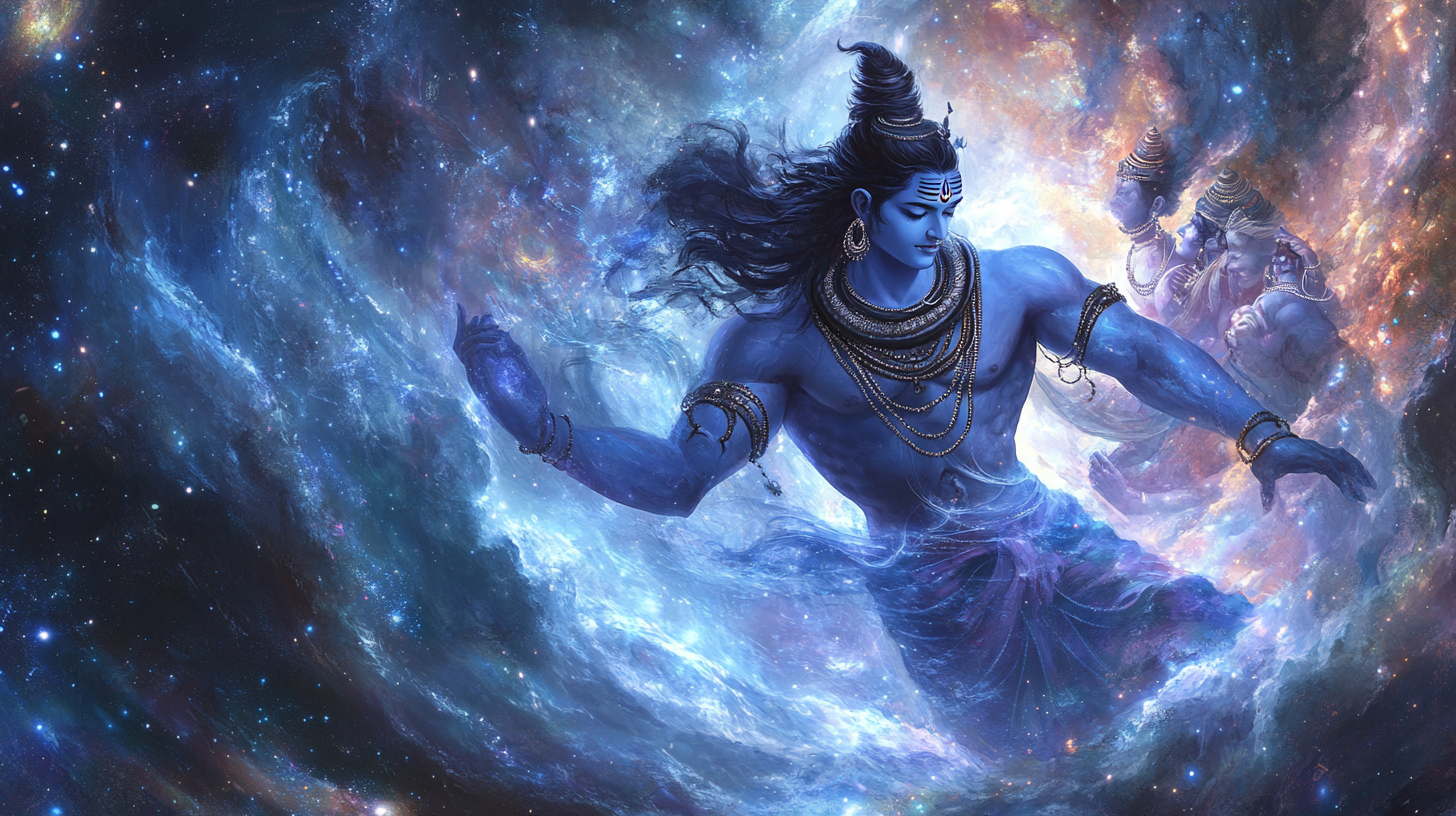
The Birth and Origin of Shiva
Shiva's existence is not bound by birth or creation like other deities. He simply is, existing beyond time and the cycle of life and death. Unlike Brahma and Vishnu, Shiva operates outside these roles, making him the most enigmatic and potent force in existence. But where did he originate from?
The Shiva Purana recounts a void before time, devoid of sky, earth, gods, or demons. From this void, a pillar of fire emerged, stretching infinitely in both directions. This pillar, with no beginning or end, defied creation or destruction. Brahma and Vishnu, witnessing this phenomenon, were awestruck by its enormity.
Seeking to prove their superiority, Brahma and Vishnu attempted to find the pillar's ends. Brahma flew upwards as a swan, while Vishnu dug deep as a boar. Despite their efforts, the pillar's vastness remained beyond their reach. Defeated, they returned, and the pillar split, revealing Shiva in all his glory.
This event underscored Shiva's supremacy, proving he was beyond creation and preservation. He was not created and was not bound by the universe's laws. Recognizing his supremacy, Brahma and Vishnu bowed to Shiva, acknowledging him as the universe's governing force.
Shiva's presence is not solely about power; it's about balance. While Brahma and Vishnu represent the cycle of existence, Shiva ensures change through destruction. This balance is why he is often depicted meditating, untouched by chaos—because he is the force that controls both.
His emergence is unique, unlike any other deity. He wasn't born to parents or from elements. He simply appeared when the universe needed him, embodying power beyond comprehension, limitation, and time itself.
For more details about his birth and his parents, read this blog Who is the Father and Mother of Shiva.
Shiva Powers
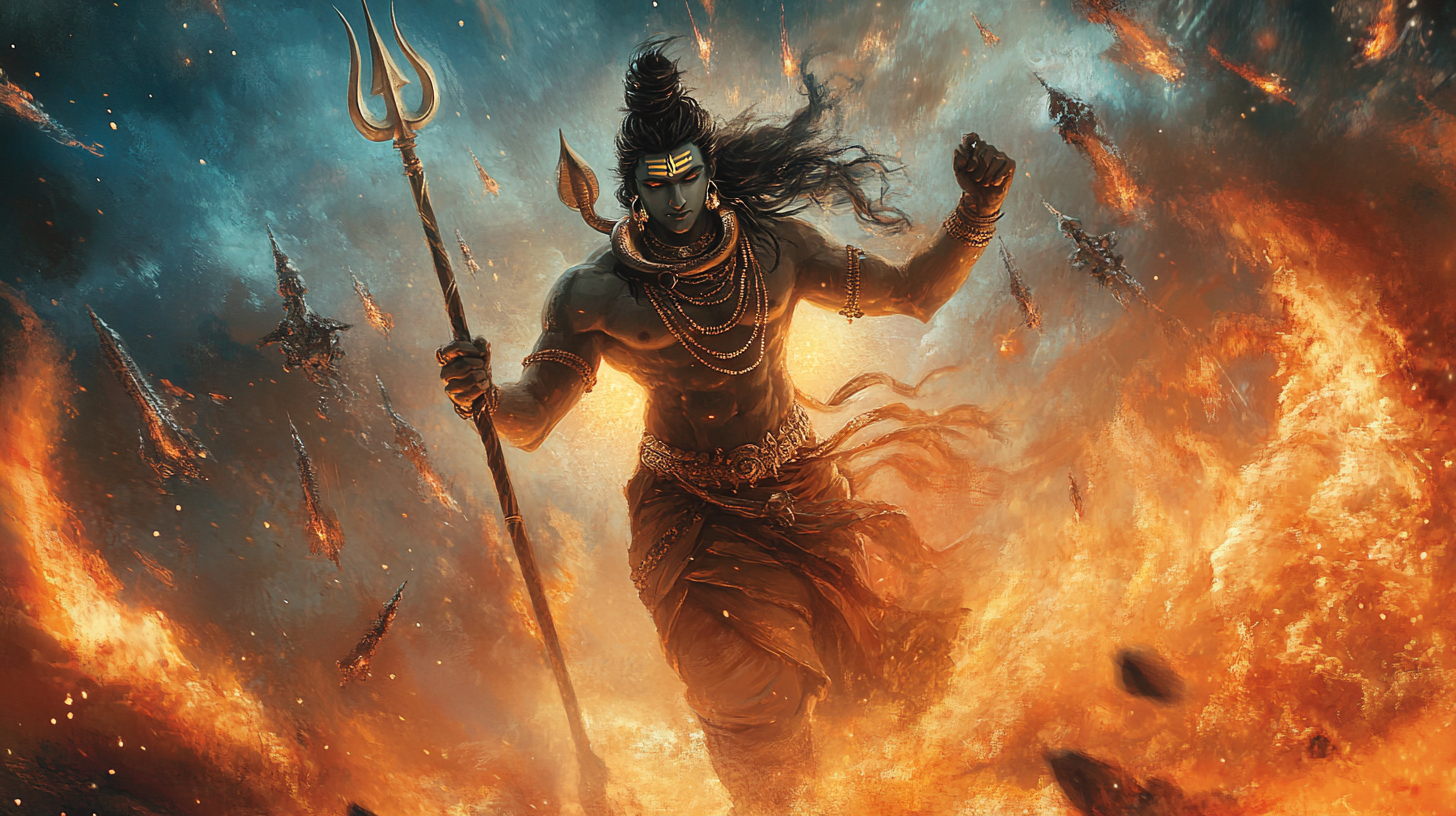
Shiva All known and Unknown Destructive weapons
The Pashupatastra, the ultimate weapon of destruction, is the most feared. It is mentioned in the Mahabharata and Shiva Purana. This celestial missile was so powerful that even the gods feared its use. Only those deemed worthy by Shiva could wield it.
Arjuna, a Pandava warrior, underwent severe penance to obtain it. Shiva warned him that misuse could destroy existence. The Pashupatastra is controlled by the wielder’s mind, eyes, and words, making it an extension of divine will.
The Trishul, Shiva’s iconic trident, is more than a weapon—it symbolizes destruction, creation, and preservation. Each prong represents time—past, present, and future. Shiva can sever anything with it, whether physical or metaphysical.
He used it to destroy the demon Tripurasura, who built three indestructible cities. Shiva merged the cities into one line of sight and struck them down with a single shot. The Tripura Samhara was a display of cosmic control.
The Rudra Astra channels Shiva’s anger. When released, it burns everything in its path, unstoppable by any force except Shiva’s will. It is feared by even the gods, as it does not discriminate.
The Maheshwarastra is another devastating weapon. It can turn mountains into dust and dry up oceans. It carries the energy of Maheshwara—Shiva in his all-powerful form. Only beings of supreme spiritual discipline can wield it.
The Bhujanga Astra is a serpent-based weapon that calls upon divine serpents to bind and annihilate enemies. When Shiva releases it, no force can break its grip. It is more powerful than the Nagastras used by other gods and warriors.
The Shiva Dhanush is a divine bow so powerful that only the greatest warriors can lift it. Parashurama once wielded it, and it tested Lord Rama’s strength. It is a test of a warrior’s destiny.
The Vajra Sanghar is a rare weapon described in esoteric texts. Unlike Indra’s Vajra, Shiva’s version can destroy celestial beings, demonic forces, and distort reality itself.
The Chakra of Time (Kala Chakra) is a concept representing Shiva’s control over existence. While Vishnu’s Sudarshan Chakra maintains dharma, Shiva’s Kala Chakra ensures the end of everything at its destined time.
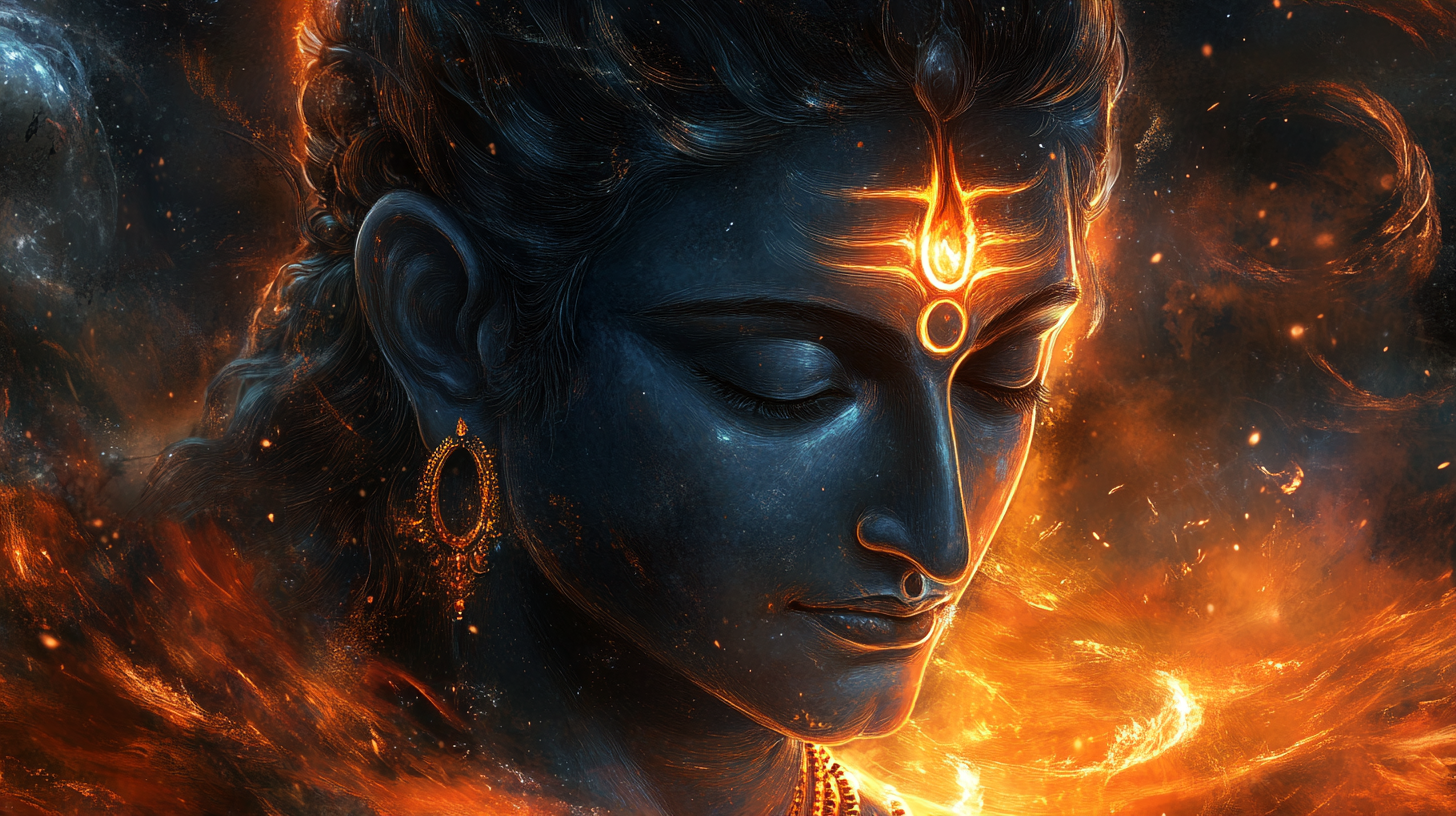
The Third Eye
Shiva’s third eye is not just an organ—it is a gateway to truth, wisdom, and power. Unlike our two eyes, which see only the material world, his third eye pierces through illusion, revealing the ultimate reality. When it opens, it does not simply see—it destroys.
The Matsya Purana narrates the incineration of Kamadeva, the god of love, by Shiva’s third eye. This demonstrates its power.
Once, the gods found themselves in trouble—Tarakasura, a mighty demon, had gained a boon that made him nearly invincible. It was prophesied that only the son of Shiva could defeat him, but there was a problem—Shiva had withdrawn into deep meditation after the loss of his beloved wife, Sati. He was completely detached from the world, lost in silence, and showed no desire to return. Without Shiva’s intervention, Tarakasura would continue his reign of terror, and the gods were desperate.
In their desperation, they turned to Kamadeva, the god of love. His arrows could stir desire in anyone’s heart—even Shiva’s. Hoping to awaken Shiva from his meditation, Kamadeva took aim and released a flowered arrow straight at Shiva. The air filled with the fragrance of spring, and for a fleeting moment, a change occurred—Shiva stirred. But the moment he realized the trick played on him, his eyes blazed with divine rage.
Without a word, his forehead split open, revealing a fiery third eye, radiating the heat of a thousand suns. Before Kamadeva could react, a searing beam shot forth, reducing him to ashes in an instant. The gods stood frozen in horror—Shiva’s third eye had unleashed a force beyond comprehension. Rati, Kamadeva’s wife, wept inconsolably, pleading for her husband’s return. Moved by her devotion, Shiva softened, granting that Kamadeva would live again, but only as a formless spirit, seen only in the emotions of love, longing, and attraction.
This story is not just about destruction; it is about perception. Shiva’s third eye represents the ability to see beyond illusion—beyond the deceptions of desire, fear, and worldly attachments. It is said that when the third eye is closed, it holds boundless wisdom, but when it opens, it burns away falsehoods, leaving only truth.
This is why Shiva is often depicted in deep meditation, his third eye closed—because true power does not come from destruction alone, but from knowing when to wield it. His third eye reminds us that real vision is not about seeing with our physical eyes but understanding the deeper truths that lie beneath the surface. It is the ability to see through deceit, to remain undisturbed by external distractions, and to recognize what truly matters.
The power of Shiva’s third eye is not just about annihilation—it is about transformation. It burns away ignorance, ego, and illusions, leaving behind clarity and enlightenment. And when the time comes, when the universe needs a reset, that same eye will open once more, turning everything into ash—only for creation to rise again from the sacred fire.
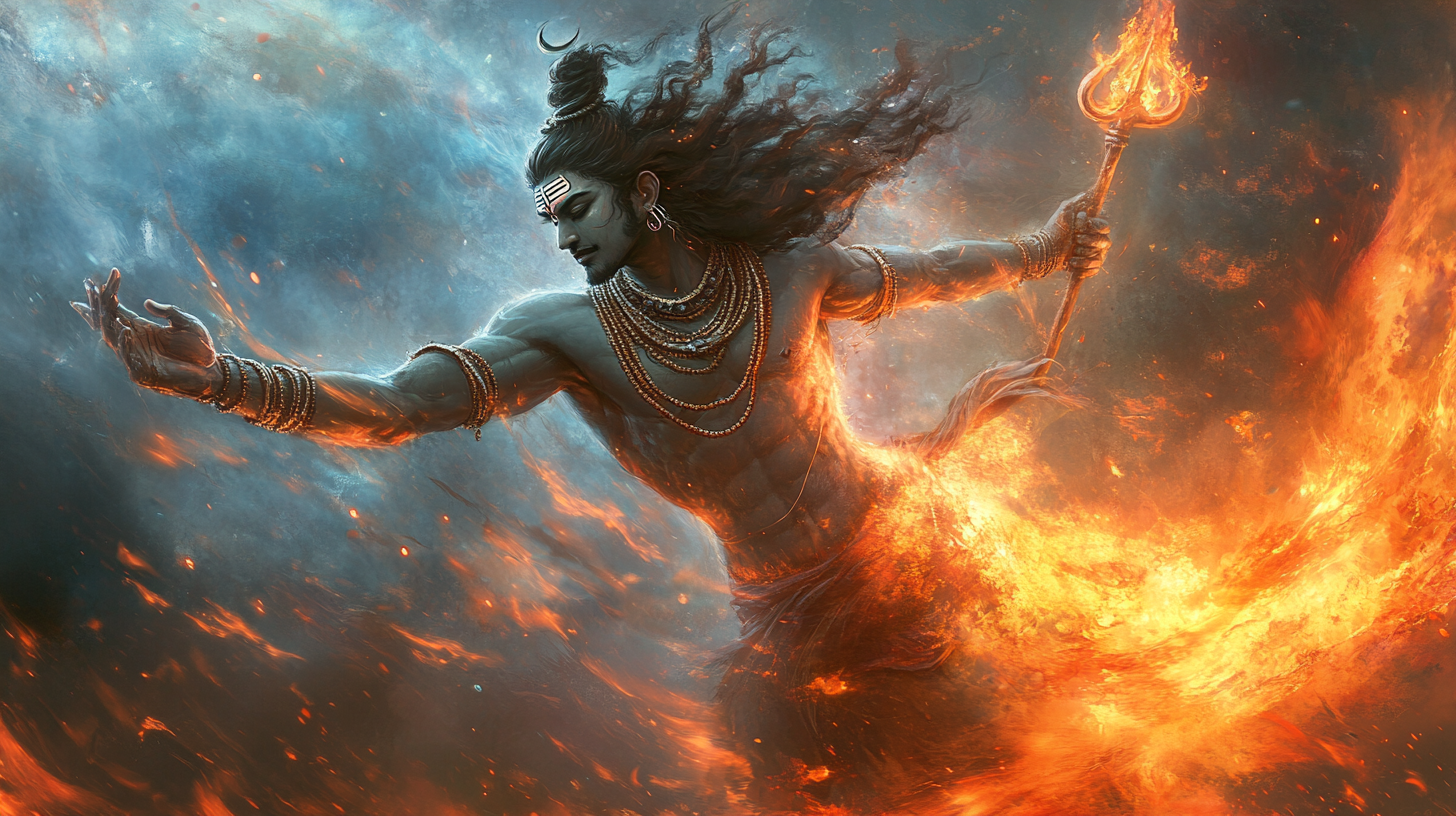
The Tandava
Shiva’s Tandava is not just a dance—it is the heartbeat of the universe. Every movement, every rhythm, and every step he takes controls the flow of existence itself. It is said that when he dances, the cosmos moves with him. The Natya Shastra and various Puranas describe this dance as the expression of his limitless power, the perfect balance of creation and destruction.
There are many forms of Tandava, but the two most well-known are Ananda Tandava, the dance of bliss, and Rudra Tandava, the dance of fury. When Shiva performs the Ananda Tandava, he radiates joy, symbolizing the eternal rhythm of life. It is in this dance that the universe finds harmony, where energies flow freely, and existence flourishes. But when he performs the Rudra Tandava, the cosmos trembles. This is the dance of destruction, where Shiva’s rage burns everything to ashes, making way for a new beginning.
One of the most famous stories about the Tandava comes from the Shiva Purana. Long ago, a demon named Apasmara, representing ignorance and arrogance, grew so powerful that even the gods could not defeat him. He believed he was invincible, mocking the divine order. To teach him a lesson, Shiva appeared in his most magnificent form—Nataraja, the cosmic dancer. He raised one foot, balancing on the demon’s back, and with a graceful yet powerful movement, he began his Tandava. The heavens shook, the earth trembled, and Apasmara realized his mistake too late. Crushed beneath Shiva’s foot, he was trapped for eternity, symbolizing that ignorance can never rise again once true wisdom is awakened.
Shiva’s Tandava is not just a myth; it is the pulse of existence. The entire universe dances to this rhythm—the rise and fall of civilizations, the birth and death of stars, the changing seasons, the ebb and flow of life itself. Science calls it the cycle of entropy and renewal, but ancient sages understood it through Shiva’s dance.
Even in our own lives, Shiva’s Tandava plays out. When we resist change, we suffer. But when we surrender to the rhythm of life—when we accept that endings are necessary for new beginnings—we move in harmony with the universe. That is the lesson of Shiva’s cosmic dance: nothing is permanent, everything is in motion, and true wisdom lies in embracing the cycle of destruction and renewal.
When the time comes for the universe to dissolve, it is said that Shiva will perform his final Rudra Tandava, destroying everything in a storm of fire and energy. But that will not be the end—it will be the beginning of something new, for from the ashes of destruction, creation will rise again.
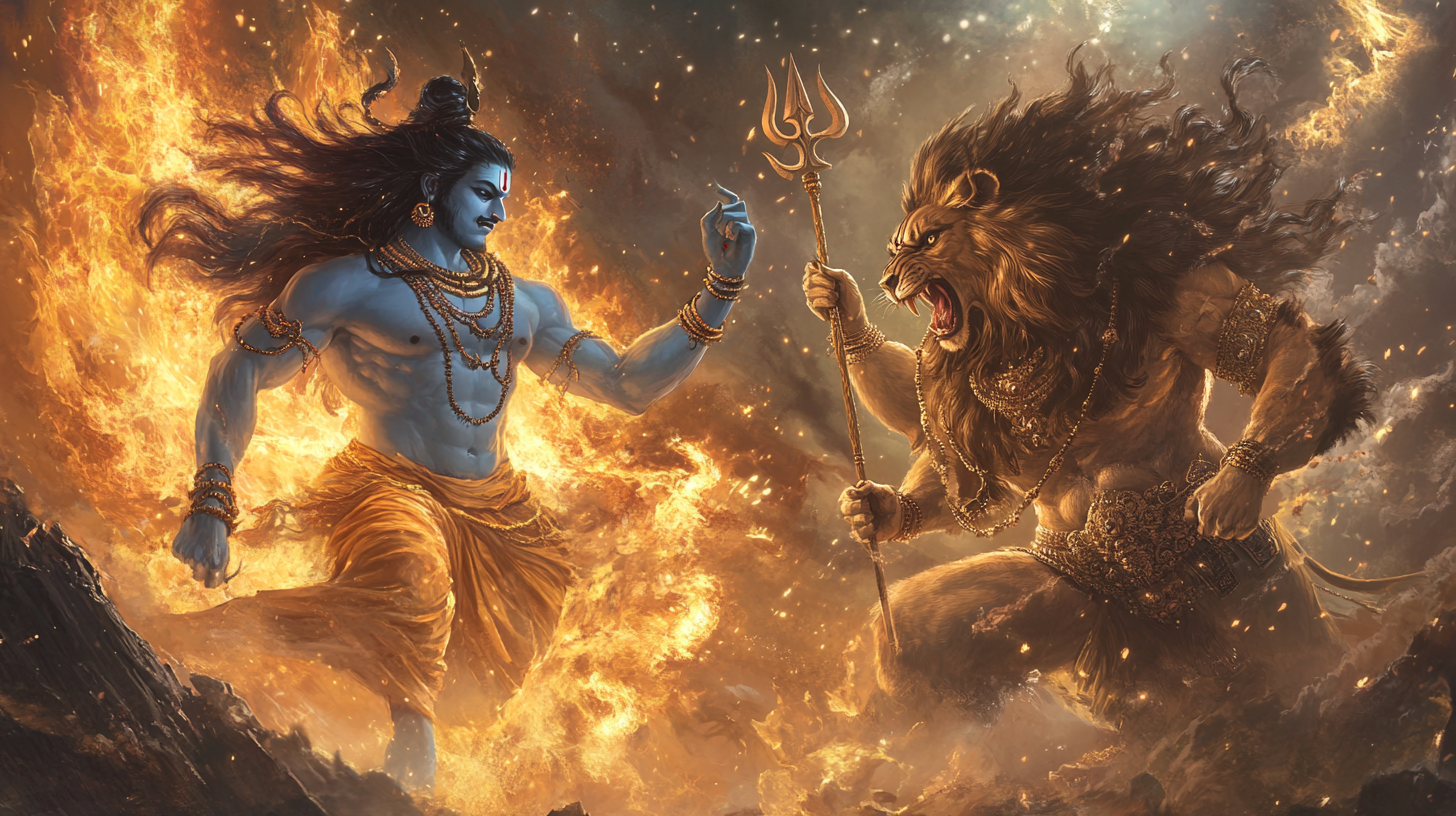
The Subduing of Narasimha
The story of Shiva subduing Narasimha is one of the most intense and awe-inspiring tales in Hindu mythology, showing the boundless power of Shiva even against the fiercest forms of divinity. This tale, mentioned in the Shiva Purana, unfolds at a time when the balance of cosmic order was threatened, not by a demon, but by an incarnation of Vishnu himself.
Hiranyakashipu, the asura king, had terrorized the three worlds, believing himself invincible due to a boon that made him immune to death by man, beast, god, or demon, neither inside nor outside, neither during the day nor night. But his own son, Prahlada, remained devoted to Vishnu, angering the tyrant. In his ultimate act of defiance, Hiranyakashipu asked if his god resided in a pillar. With unwavering faith, Prahlada answered yes. Enraged, the king struck the pillar, and from it emerged Narasimha—Vishnu’s terrifying half-man, half-lion form.
In a furious display of divine justice, Narasimha tore Hiranyakashipu apart at twilight, at the threshold of a palace, with his claws—fulfilling the conditions of the boon. Yet, after the battle, Narasimha did not calm down. His rage had grown so intense that it threatened the very existence of the world. The gods trembled, unable to contain his fury. Even Vishnu’s consort, Lakshmi, could not pacify him.
Fearing that Narasimha’s wrath would consume everything, the gods turned to Shiva. Only he, the Supreme Destroyer, could counter this uncontrollable force. Answering their call, Shiva manifested in a form never seen before—Sharabha, a mighty creature with the body of a lion, enormous wings, and a fierce yet majestic presence. Some texts describe him as a part-bird, part-lion being, symbolizing absolute power and control.
Sharabha soared through the skies, his enormous wings spreading across the heavens, darkening the cosmos. As he approached Narasimha, the raging avatar saw him as a challenger and leaped forward, roaring with divine fury. But Shiva, in his Sharabha form, moved with unmatched grace and power. With a swift motion, he wrapped Narasimha in his wings, holding him in an unbreakable grip. The struggle shook the universe, but no force could withstand Shiva’s divine might.
As Shiva’s energy merged with Narasimha’s, the terrifying rage of the Vishnu-avatar began to subside. Narasimha realized that his wrath had consumed him beyond purpose, and under the calming force of Shiva’s embrace, he surrendered. The cosmic balance was restored, and the world was saved from destruction.
This story does not depict a rivalry between Vishnu and Shiva; it shows the interplay of cosmic forces. Even the fiercest, most uncontrollable energy must eventually submit to Shiva, the ultimate force of transformation. Shiva’s Sharabha form is not about domination but about restoring harmony when chaos reaches its peak.
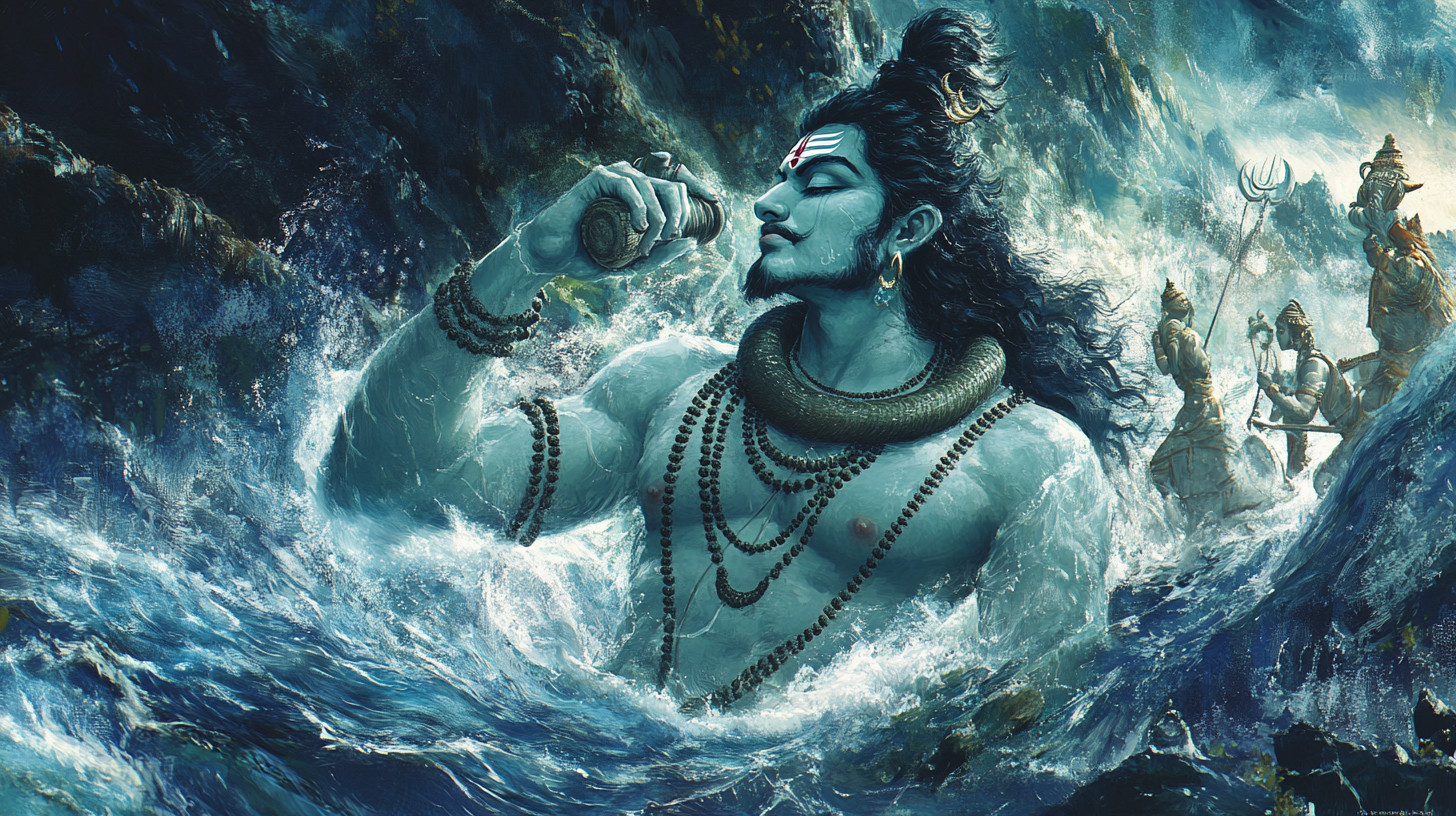
The Churning of the Ocean (Samudra Manthan)
The churning of the ocean, Samudra Manthan, was a cosmic battle of patience, power, and destiny. Gods and demons joined forces to find the nectar of immortality. But their quest unleashed the poison Halahala, a force so deadly it could destroy all creation.
Lord Shiva was the only one strong enough to face it. His strength saved the universe from destruction.
According to the Bhagavata Purana, the devas and asuras churned the ocean. They used Mount Mandara as a churning rod and Vasuki, the divine serpent, as the rope. As they churned, the ocean revealed treasures like precious gems and divine animals.
But before the nectar emerged, the dark poison Halahala surfaced. It was a force of pure destruction, threatening to wipe out all life.
The gods, despite their power, could not withstand its potency. The devas and asuras panicked, realizing their greed had put creation at risk.
They turned to Lord Shiva, the only one who could face death without fear. Shiva stepped forward without hesitation. He chose to embrace the poison himself, drinking it in one swift motion.
His skin turned deep blue as the poison touched his throat. An unbearable burning sensation coursed through his being. The gods and goddesses, including his beloved Parvati, watched with concern.
Parvati pressed her hand against his throat, stopping the poison from spreading. It remained trapped in his throat, turning his neck permanently blue. From then on, Shiva was known as Neelkanth—the Blue-Throated One.
Shiva did not just drink the poison; he held it within him, absorbing its deadly force. He remained calm, unaffected by the agony that would have destroyed anyone else. The universe was saved, but at a great cost—Shiva had endured unimaginable pain to protect creation.
This act showcased his boundless compassion. Unlike other gods, Shiva alone took upon himself the burden of the poison. His sacrifice ensured the Samudra Manthan could continue, leading to the emergence of amrit and granting immortality to the devas.
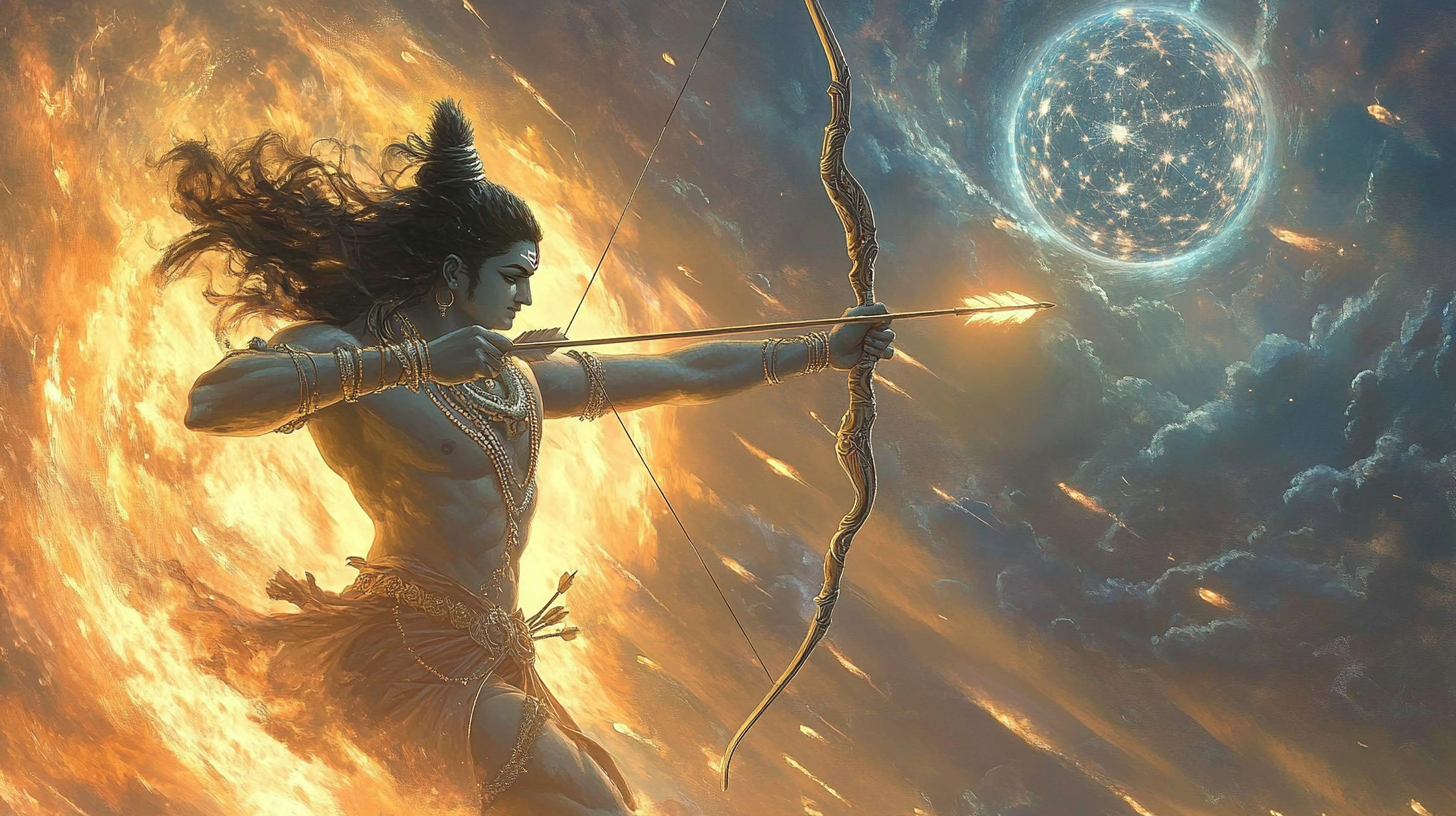
The Destruction of Tripura (Tripurantaka)
Long ago, three mighty asuras—Taraka's sons, Tarakaksha, Kamalaksha, and Vidyunmali—performed severe penance to please Lord Brahma. After years of unwavering devotion, Brahma appeared before them, granting them a boon. They wished for three floating cities—one made of gold, another of silver, and the last of iron—so powerful that they could never be destroyed except by a single arrow shot when all three aligned in a straight line, an event that would occur only once in a thousand years. Brahma, bound by the rules of cosmic balance, granted their wish.
With this boon, the asuras became nearly invincible. Their cities, known collectively as Tripura, floated through the skies, constantly shifting and never aligning. The demons, empowered by their indestructible fortresses, unleashed terror across the three worlds, attacking sages, conquering lands, and even challenging the gods themselves. The devas, unable to withstand their wrath, turned to Lord Shiva for help.
Shiva, ever calm, listened to their plea but did not act immediately. He knew that every destruction must serve a purpose, and mere vengeance was never his way. The devas, growing restless, sought help from Vishnu, who devised a strategy. He entered Tripura disguised as a teacher and misled the demons into abandoning their devotion to dharma. Once they lost their virtue, their end was inevitable.
The moment arrived when the three cities aligned in a straight line. Shiva, understanding that this was the only chance to destroy them, prepared for battle. But this was no ordinary battle—it was a cosmic event. The gods united to create a divine chariot for him:
- Vishnu became the arrow,
- Brahma became the charioteer,
- Meru became his bow,
- Vasuki, the serpent, became the bowstring,
- The Earth itself became his chariot, and
- The Sun and Moon became its wheels.
With the cosmos itself as his weapon, Shiva, now known as Tripurantaka, mounted his divine chariot. As the precise moment arrived, he pulled the bowstring and released a single arrow. The power of that one arrow was beyond comprehension—it cut through the skies, struck all three cities at once, and reduced them to ashes in an instant.
The devas and sages rejoiced, but Shiva remained unmoved. For him, destruction was never about power—it was about restoring balance. He had not destroyed Tripura out of anger or personal gain but to eliminate the unchecked evil that had spread across the universe.
What makes this story even more profound is what happened next. As Shiva stood victorious, he saw the surviving asuras bow before him, seeking mercy. Unlike other gods who might have punished them further, Shiva, the compassionate one, forgave them and blessed them with wisdom.

Shiva as the Benevolent Protector
Shiva, despite being the great destroyer, is also the most benevolent protector. He doesn’t discriminate between gods, demons, or humans—anyone who seeks him with devotion receives his grace. His compassion is boundless, and there are countless stories in the Puranas that illustrate his role as a protector and benefactor.
One of the most well-known stories is that of Markandeya, from the Shiva Purana. Markandeya was a young boy, born to sage Mrikandu and his wife after they had prayed to Shiva for a child. Their boon came with a condition—Markandeya would live for only sixteen years. Despite knowing his fate, Markandeya was a devoted follower of Shiva and spent his life in unwavering worship. On the day of his destined death, when Yama, the god of death, arrived to take his soul, Markandeya ran to the Shiva Linga and embraced it tightly. Yama threw his noose, but in that moment, the Linga burst open, and Shiva emerged, furious. He struck Yama down, bringing him to the brink of death, and declared that no devotee of his would ever be taken against their will. Humbled, Yama revived and granted Markandeya eternal life. This story shows that Shiva’s protection transcends even death itself.
Another powerful tale is that of Ravana, the mighty king of Lanka. Despite being a rakshasa, Ravana was an ardent devotee of Shiva. He once attempted to lift Mount Kailash to prove his strength, but when Shiva pressed it down with just his toe, Ravana was crushed beneath it. Realizing his arrogance, Ravana sang hymns of devotion—the Shiva Tandava Stotra—for days. Pleased with his sincerity, Shiva not only freed him but also gifted him the Chandrahasa, a divine sword of immense power. This story shows that Shiva is not swayed by good or evil—what matters to him is devotion.
There’s also the story of Bhasmasura, a demon who performed severe penance to please Shiva. When Shiva appeared before him, Bhasmasura asked for a dangerous boon—the power to turn anyone to ashes by merely touching their head. Without hesitation, Shiva granted it. But the demon, overcome with greed, tried to test it on Shiva himself. Realizing the danger, Shiva fled, seeking help from Vishnu, who took the form of the enchanting Mohini. Bhasmasura, mesmerized by her beauty, accepted her challenge to mimic her dance. As she playfully placed her hand on her own head, the foolish demon did the same—and was reduced to ashes instantly. Though this story highlights the dangers of unchecked power, it also shows how Shiva grants boons freely, believing in the sincerity of his devotees.
One of the most moving stories is that of Kannappa, a simple hunter who became one of Shiva’s greatest devotees. He worshipped Shiva in his own way—offering raw meat, washing the Linga with water from his mouth, and adorning it with whatever he could find. One day, he saw blood flowing from the Shiva Linga’s eye. Seeing it as a wound, he plucked out his own eye and placed it on the Linga. When the second eye started bleeding, he prepared to sacrifice his other eye, but before he could, Shiva appeared and stopped him. Overwhelmed by such devotion, Shiva blessed Kannappa with immortality and declared that pure love matters more than rituals.
These stories, and many more, show that Shiva is not just a god of destruction but also a loving protector. He does not look at status, power, or even morality—only devotion and sincerity matter to him. His grace is limitless, and he always stands by those who seek him with a true heart.
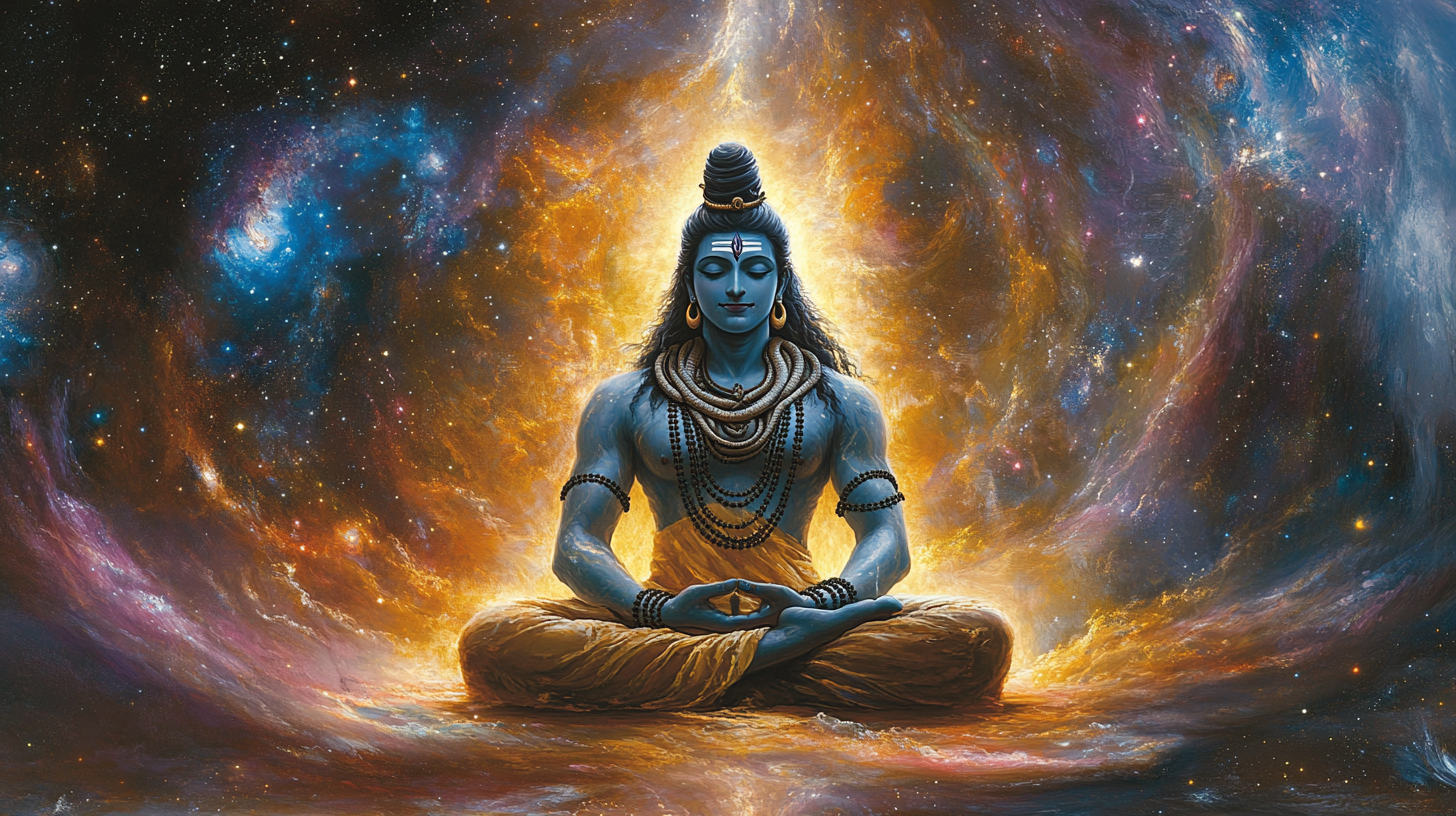
Conclusion
Shiva’s power is beyond comprehension, yet his heart is filled with boundless compassion. He is the force that destroys, but only to rebuild. He is the ultimate protector, granting boons even to demons, yet ensuring justice prevails. From incinerating Kamadeva with his third eye to pacifying Narasimha as Sharabha, from swallowing the deadly Halahala to destroying the mighty Tripura with a single arrow—each story from our sacred texts speaks of his unmatched might. But what truly sets him apart is his love for his devotees. Whether it is a young boy like Markandeya, a king like Ravana, or a humble hunter like Kannappa, Shiva responds not to power or wisdom but to devotion. He is beyond fear, beyond time, and beyond judgment. To understand Shiva’s power is to realize that destruction and creation are two sides of the same coin—one cannot exist without the other. And in that eternal dance of existence, Shiva stands as the ultimate force, both terrifying and loving, always watching over those who call upon him with faith.
If you are a devotee who seeks Shiva’s blessings and wants to keep his divine presence close, you can check out our beautifully crafted Shiva Idol under our brand Dev Tattva. Perfect for car dashboards, home temples, offices, or any sacred space, this idol is designed to bring peace, protection, and spiritual energy into your surroundings.
Discover our Shiva Idol at: Dev Tattva - Shiva Idol. Let the spirit of Mahadev enter your world. 🚩🔱
Har Har Mahadev 🚩🔱
Our latest content
Check out what's new in our company !
How Powerful is Shiva